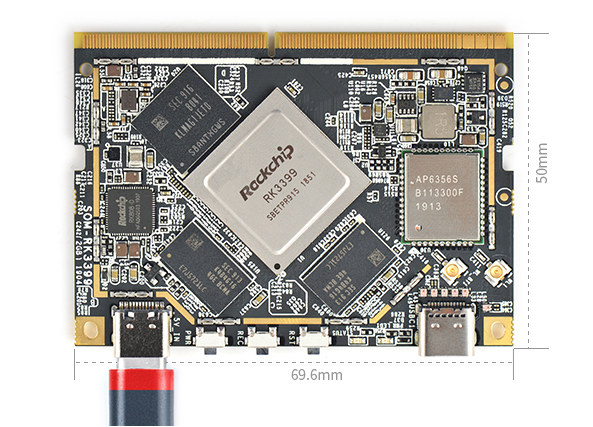FriendlyELEC is better known for their low-cost tiny single board computers, but the company has also introduced systems-on-module in the past such as Smart6818 module powered by Samsung S5P6818 octa-core processor.
The company has now launched another system-on-module with SOM-RK3399, which as its name implied features Rockchip RK3399 processor, as well as a corresponding carrier board mostly designed for artificial intelligence and computer vision applications.
SOM-RK3399 System-on-Module
Specifications:
- SoC – Rockchip RK3399 big.LITTLE hexa-core processor with 2x Cortex-A72 cores up to 2.0GHz, 4x Cortex-A53 cores up to 1.5GHz, Mali-T864 GPU with support for OpenGL ES1.1/2.0/3.0/3.1, OpenVG1.1, OpenCL, DX11, and AFBC, and VPU capable of handling 4K VP9 and 4K 10bits H265/H264 60fps decoding, Dual VOP, etc
- System Memory – Dual-Channel 2GB DDR3
- Storage – 16GB eMMC 5.1 flash
- Networking
- 802.11a/b/g/n/ac, Bluetooth 4.1, Wi-Fi and Bluetooth combo module (AP6356S), dual antenna interface
- Realtek RTL8211E Gigabit Ethernet transceiver
- USB – 2x USB-C ports on the module
- 260-pin edge connector with
- Storage – 1x SDIO/MMC for SD card
- Networking – Gigabit Ethernet
- Video Input – 1x or 2x 4-Lane MIPI-CSI dual ISP, up to 13MPix/s, supports simultaneous input of dual camera data
- Video output
- HDMI 2.0a up to 4K @ 60Hz, HDCP 1.4/2.2
- DisplayPort 1.2 Alt Mode on USB Type-C port
- LCD interfaces – 1x 4-lane eDP 1.3 connector up to 10.8Gbps. 1x or 2x 4-Lane MIPI-DSI
- USB – 2x USB 2.0 interfaces, 1x USB 3.0 host interface,
- PCIe x4, compatible with PCIe 2.1, Dual operation mode;
- Other I/Os – 14x GPIO (6x 1.8V/8x 3.3V), 1x I2S, 2x I2C (1.8V/3.3V), 2x PWM, 1x UART / SPI, ADC, 1x IR-RX, 1x SPDIF_TX, 3x 1.8V ADC inputs
- Debugging -Debug UART, 3V level, 1500000bps
- Misc – Power, Reset, and Recovery buttons, power LED, 1x user LED
- Power Supply
- 5V input via USB type-C port
- RK808-D PMIC with independent DC/DC, enabling DVFS, software power-down, RTC wake-up, system sleep mode
- Dimensions – 69.6 x 50 mm; 8-layer PCB
- Temperature Range – -20°C to 70°C
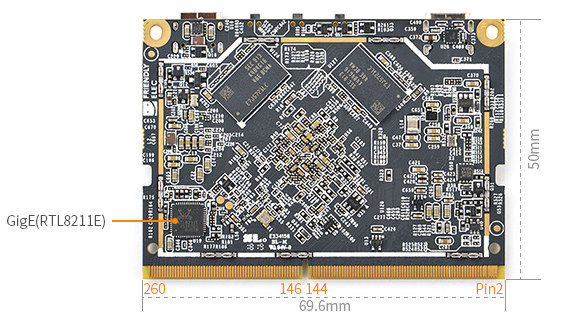 In theory, the module can work in standalone, as you can just use the USB-C port on the left for power, and the USB-C port on the right to connect to a display, Ethernet and/or USB input devices via an adapter. But obviously that only really works for applications where you don’t need access to the many I/O’s offered by the module. One potential application might be digital signage where you need just a power supply, and a display while getting the media files over WiFi.
In theory, the module can work in standalone, as you can just use the USB-C port on the left for power, and the USB-C port on the right to connect to a display, Ethernet and/or USB input devices via an adapter. But obviously that only really works for applications where you don’t need access to the many I/O’s offered by the module. One potential application might be digital signage where you need just a power supply, and a display while getting the media files over WiFi.
SOM-RK3399 support Android 7 & 7, FriendlyCore OS based on Ubuntu Core 16.04 or 18.04, as well as Armbian and Lubuntu since it can leverage the software work done for FriendlyELEC RK3399 SBC’s. The company also provides Rockchip’s Android NN SDK with Android 8.1 to leverage GPU acceleration for AI workloads. You’ll find download links and documentation in the Wiki.
SOM-RK3399 Dev Kit Carrier Board
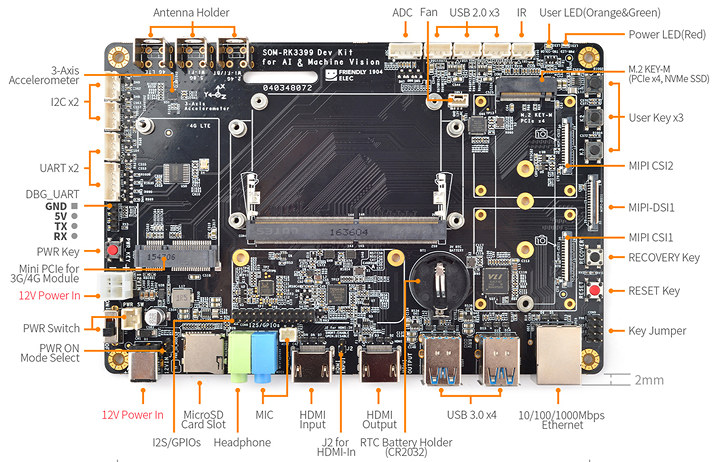
Most people will likely want to get started with SOM-RK3399 development kit to easily access all of the interfaces exposed by the module.
Key features and specifications of the carrier board:
- Supported SoM – SOM-RK3399 with 2GB DDR3 and 16GB eMMC flash as described above
- Storage – 1x microSD card slot, M.2 NVMe SSD support (see PCIe expansion slot below)
- Video Output
- 1x HDMI 2.0a port up to 4K @ 60Hz with HDCP 1.4/2.2
- DisplayPort 1.2 Alt Mode on USB Type-C (on module)
- 1x 4-lane eDP 1.3 connector
- 2x 4-Lane MIPI-DSI connectors including one multiplexed with MIPI CSI
- Video In/Camera interface
- 1x HDMI input up to 1080p30, 720p60 supporting both video and audio recording
- Up to 2x 4-Lane MIPI-CSI connectors up to 13MPix/s
- Audio – 1x 3.5mm stereo headphone jack, 1x 3.5mm microphone Jack, 1x PH2.0 connector for microphone
- Connectivity
- Gigabit Ethernet (RJ45)
- 802.11b/g/n/ac Wi-Fi 5 and Bluetooth 4.1 (via SoM)
- 1x MiniPCIe Socket and microSIM slot for optional 4G LTE module
- USB
- 1x USB Type-C Port
- 4x USB3.0 Type-A ports
- 3x USB2.0 PH2.0 4-pin connectors
- Expansion
- 1x PCIe x4 M.2 Key-M Socket
- Various headers with 3x ADC, 1x IR-IN, 2x I2C, 2x UART, 1x 8ch-I2S, 3x GPIO, 1x SPDIF-TX
- Misc – 3x UserKey, 1x power LED, 1x dual color user LED, CR2032 battery slot for RTC, 12V cooling fan interface
- Power Supply – 12V DC
- Dimensions – 185 x 123 mm; 4-layer PCB
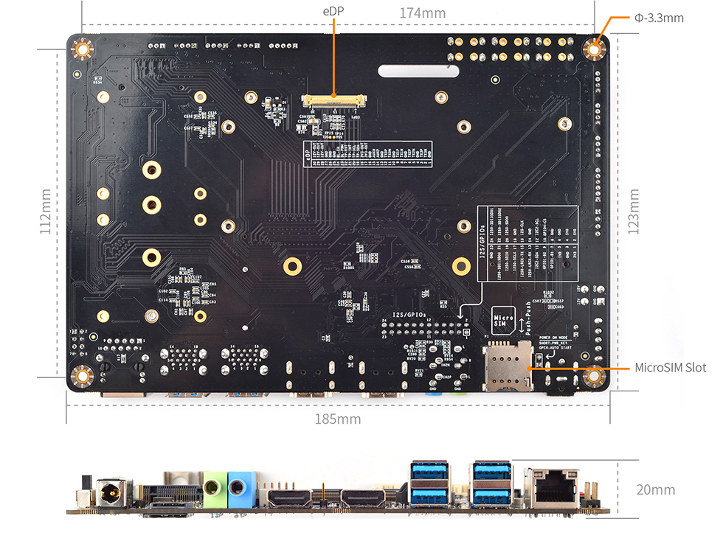 The Wiki for the carrier board contains more details information about the pin layout and other technical parameters.
The Wiki for the carrier board contains more details information about the pin layout and other technical parameters.
SOM-RK3399 module is sold for $75 with two free antennas. Accessories useful for the carrier board are also available as an option, including 7″ and 11.6″ eDP touchscreen displays, MIPI camera modules, and so on, but for some reasons, the company did not add the actual carrier board in their shop. Hopefully, they just forgot to list it on their website and will fix this tomorrow. [Update: The complete SOM-RK3399 development kit is now available with the carrier board, SOM-RK3399 module, the heatsink fan pictured below, two antennas, a USB-C cable, a 12V/2A power adapter, and a USB to UART debug board for $120 plus shipping]
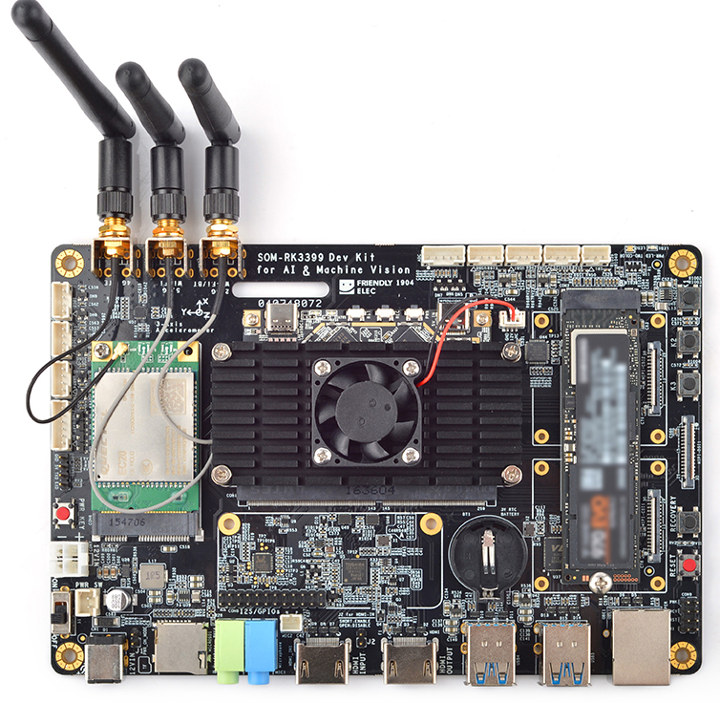
Thanks to theguyuk for the tip.

Jean-Luc started CNX Software in 2010 as a part-time endeavor, before quitting his job as a software engineering manager, and starting to write daily news, and reviews full time later in 2011.
Support CNX Software! Donate via cryptocurrencies, become a Patron on Patreon, or purchase goods on Amazon or Aliexpress


